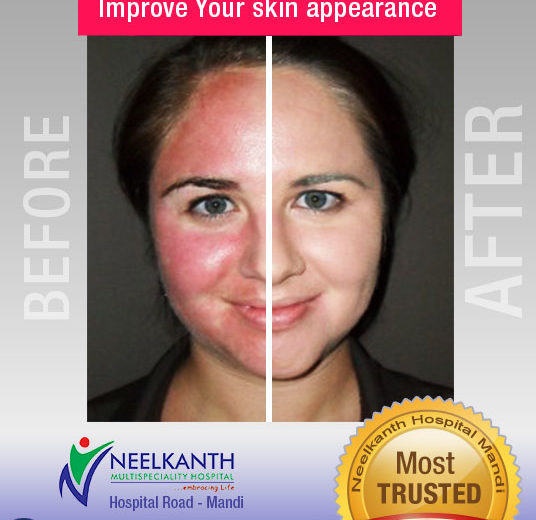A chemical peel is a solution applied to the face to remove the outermost layer or layers of skin. It’s a technique used to improve the appearance of the skin on the face, neck or hands. A chemical solution is applied to the skin that causes it to exfoliate and eventually peel off. If you are looking for Laser Treatment in Himachal, for lighten your skin tone or remove skin patches, consult our best dermatologist in himachal, Dr. Sahil Mrigpuri. The new skin that grows in its place is softer, smoother and has fewer imperfections. The new skin is also temporarily more sensitive to the sun.
Chemical peels are used to treat a number of conditions including:-
1. Pigmentation on face or body
2. Tanning
3. Fine Wrinkles
4. Acne
5. Acne marks and scars
6. Dullness
7. Aging skin
8. Crow’s feet
9. Sagging skin
Chemical peels come in a variety of strengths and types. Glycolic acid, trichloroacetic acid, salicyclic acid, lactic acid, or carbonic acids are used, sometimes in combinations. The application can take as little as 15 minutes. There may be mild redness and irritation afterwards, but most people return to normal activities immediately. It’s important to wear sunscreen to protect your vulnerable skin after a chemical peel. Consult Best Skin Specialist in Himachal, to recover your skin from ageing , dark patches, wrinkles.
How Chemical Peel Works?
Chemical peel works on three basic principals’ i.e. Exfoliation, Removal of skin imperfections, Regeneration In this process, chemical peels are applied directly to the skin which destroys the outer layer of the skin through chemical activities. However, a controlled destruction of epidermis is there so as to avoid excessive damage to skin. Destruction of epidermis leads to the exfoliation and removal of superficial lesions on the skin followed by the regeneration of new epidermal & dermal tissues.
Chemical peel is largely a cosmetic procedure and it is indicated depending upon the patient’s requirement to correct skin textural problems. Here are the skin condition that chemical peels treat:-
- Skin lesions: Acne Vulgaris, Rosacea in remission
- Acne Complications: Hyper-pigmentation, Athropic scars & Enlarged skin pores
- Skin Hyper-pigmentation: On Hormonal basis, connected to age or caused by sun radiation
- Wrinkles: Solar origin as well as mimic & those connected to age
- Others: Melasma, Freckles, Lentigines, Facial Melanoses, Periorbital hyper-pigmentation
Procedure of Chemical Peel :-
A chemical peel can be used to treat various skin problems. Depending on the issues you’re addressing with the procedure, you’ll choose a chemical peel in one of three depths:
- Light chemical peel. A light (superficial) chemical peel removes the outer layer of skin (epidermis). It can be used to treat fine wrinkles, acne, uneven skin tone and dryness. You might have a light chemical peel as often as every two to five weeks — depending on your desired results.
- Medium chemical peel. This type of chemical peel removes skin cells from the epidermis and from portions of the upper part of your middle layer of skin (dermis). A medium chemical peel can treat wrinkles, acne scars and uneven skin tone. You might repeat a medium chemical peel after three to nine months to maintain results.
- Deep chemical peel. A deep chemical peel removes skin cells from the epidermis and from portions of the mid to lower layer of your dermis. Your doctor might recommend a deep chemical peel if you have deeper wrinkles, scars or precancerous growths. A deep chemical peel can only be performed once
If you decide to proceed with the chemical peel, you might also need to follow these safety measures :-
- Take antiviral medication. If you have a history of herpes infections around your mouth, your doctor will likely prescribe an antiviral medication before and after treatment to help prevent a viral infection.
- Use a retinoid cream. If you’re having a light or medium chemical peel, your doctor might recommend using a retinoid cream, such as tretinoin (Renova, Retin-A, others), beforehand to shorten your treatment time and speed the healing process.
- Use a bleaching agent. Our doctor might recommend using a bleaching agent (hydroquinone) and a retinoid cream before or after the procedure to prevent skin darkening.
- Avoid unprotected sun exposure. It’s important to consistently use sunscreen at least four weeks before the procedure to help prevent irregular pigmentation in treated areas. Discuss sun protection and acceptable sun exposure with your doctor.
- Avoid certain cosmetic treatments and certain types of hair removal. About a week before the peel, stop waxing or using depilatory hair-removal products. Also, avoid bleaching, massages or facial scrubs in the week before your peel.
- Arrange for a ride home. If you’ll be sedated during a medium or deep chemical peel, you’ll need help getting home after the procedure.
To find out more about Laser treatment at Neelkanth Hospital contact us or call +91-82787-26347




